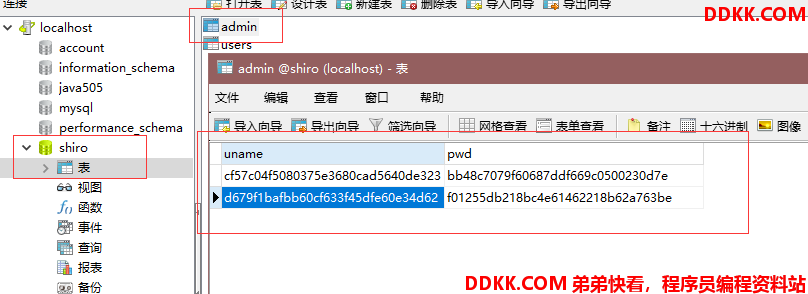- 在身份认证的过程中往往都会涉及到加密,如果不加密,这个时候信息就会非常的不安全,shiro 中提供的算法比较多
- 如 MD5 SHA 等
1.手动处理数据时,自行使用MD5加密
package com.shiro3;
import org.apache.shiro.crypto.hash.Md5Hash;
public class TestDemo {
public static void main(String[] args) {
//使用MD5加密
Md5Hash md5 = new Md5Hash("DQC");
System.out.println("DQC==" + md5);
//加盐
md5 = new Md5Hash("DQC", "DQCGM");
System.out.println("DQC==" + md5);
//迭代次数
md5 = new Md5Hash("DQC", "DQCGM", 2);
System.out.println("DQC==" + md5);
}
}
运行结果:

2.使用Shiro的MD5方式进行加密
数据库:

[main]
#设置securityManager中realm
credentialsMatcher=org.apache.shiro.authc.credential.HashedCredentialsMatcher
#设置加密方式
credentialsMatcher.hashAlgorithmName=md5
#设置迭代次数
credentialsMatcher.hashIterations=2
userRealm=com.shiro3.UserRealm
userRealm.credentialsMatcher=$credentialsMatcher
securityManager.realms=$userRealm
package com.shiro3;
import org.apache.shiro.authc.AuthenticationException;
import org.apache.shiro.authc.AuthenticationInfo;
import org.apache.shiro.authc.AuthenticationToken;
import org.apache.shiro.authc.SimpleAuthenticationInfo;
import org.apache.shiro.authz.AuthorizationInfo;
import org.apache.shiro.realm.AuthorizingRealm;
import org.apache.shiro.subject.PrincipalCollection;
import org.apache.shiro.util.ByteSource;
import java.sql.Connection;
import java.sql.DriverManager;
import java.sql.PreparedStatement;
import java.sql.ResultSet;
public class UserRealm extends AuthorizingRealm {
//认证
@Override
protected AuthenticationInfo doGetAuthenticationInfo(AuthenticationToken authenticationToken) throws AuthenticationException {
try {
Class.forName("com.mysql.jdbc.Driver");
Connection conn = DriverManager.getConnection("jdbc:mysql://127.0.0.1:3306/shiro", "root", "Root");
PreparedStatement prepareStatement = conn.prepareStatement("select uname,pwd from admin ");
ResultSet rs = prepareStatement.executeQuery();
System.out.println(rs);
while (rs.next()) {
//ByteSource.Util.bytes("DQCGM")是加盐的盐是什么
SimpleAuthenticationInfo info = new SimpleAuthenticationInfo(rs.getString("uname"), rs.getString("pwd"), ByteSource.Util.bytes("DQCGM"), "userRealm");
return info;
}
} catch (Exception e) {
e.printStackTrace();
}
return null;
}
//授权
@Override
protected AuthorizationInfo doGetAuthorizationInfo(PrincipalCollection principalCollection) {
return null;
}
}
package com.shiro3;
import org.apache.shiro.SecurityUtils;
import org.apache.shiro.authc.IncorrectCredentialsException;
import org.apache.shiro.authc.UnknownAccountException;
import org.apache.shiro.authc.UsernamePasswordToken;
import org.apache.shiro.config.IniSecurityManagerFactory;
import org.apache.shiro.mgt.SecurityManager;
import org.apache.shiro.subject.Subject;
import org.apache.shiro.util.Factory;
public class TestB {
public static void main(String[] args) {
/*Realm*/
//[1]解析shiro.ini文件
Factory<SecurityManager> factory = new IniSecurityManagerFactory("classpath:shiro-jdbc3.ini");
//[2]通过SecurityManager工厂获得SecurityManager实例
SecurityManager securityManager = factory.getInstance();
//[3]把SecurityManager对象设置到运行环境中
SecurityUtils.setSecurityManager(securityManager);
//[4]通过SecurityUtils获得主体subject
Subject subject = SecurityUtils.getSubject();
//[5]书写自己输入的账号和密码---相当于用户自己输入的账号和密码
//我们拿着自己书写用户名密码去和shiro.ini 文件中的账号密码比较
UsernamePasswordToken token = new UsernamePasswordToken("DQCGM", "123");
try {
//[6]进行身份的验证
subject.login(token);
//[7]通过方法判断是否登录成功
if (subject.isAuthenticated()) {
System.out.println("登录成功");
}
} catch (IncorrectCredentialsException e) {
System.out.println("登录失败");
} catch (UnknownAccountException e) {
System.out.println("用户名不正确");
}
}
}
运行结果:
